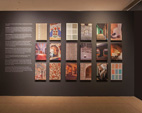Man’s desire for identity, shelter and beauty is perhaps best manifested through us.
NARRATIVES: In India, we’ve made interesting canvases for storytelling – depending on their desired function, votive figures, religious motifs and decorative themes transformed rooms. In some instances, adornment still pertains to special occasions, making us bulletins that bear witness to your life’s moments.
STYLE & TECHNIQUE: The use of wood, stone, marble, mother-of -pearl and mirrors as inlaid or relief had long been practice. Parchinkari or pietradura were classic examples of inlay, during Mughal times,where surfaces were fitted with contrasting pieces to form flush patterns.
Relief referred to the practice of chiselling to createraised patterns, which were then painted or embellished. In the houses of Kutch, Kathiawad and far western Rajasthan, geometric patterns are still created using bamboo and twigs, then plastered and embellished with mirrors, to
sculptural effect.
PIGMENT & MATERIALS: Traditionally, mud and dung was used on walls for purposes of breathability, repelling insects and natural cooling. Natural pigments were used for adornment;where white was obtained from rice, chalk or lime, yellow from turmeric,
green from leaves, blue from flowers like datura, and black from coal or burnt coconut shells.
Over time, these organic practices were replaced by paintin most regions.
In middle-class homes, lime or chuna wash was the staple finish.
Paint was virtually a foreign province with few Indian companies like Shalimar Paints. When World War II interrupted imports in 1942, four friends founded Asian Paints. In less than two decades, the company became India’s leading manufacturer for paints. Today, it is Asia’s third largest
paints company.
As people gain global exposure, the ideaof using us, to express themselvesalso changes. With the emergence of standardised relief finishes, decorative wallpapers, and the Automated Colour Dispensing Machine, the palette has expanded exponentially, enabling us, the walls of Indian homes, with many more stories to tell.




